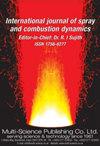基于火焰传递函数修正的稳健性燃烧室设计
IF 2.1
4区 工程技术
Q3 ENGINEERING, MECHANICAL
International Journal of Spray and Combustion Dynamics
Pub Date : 2022-03-01
DOI:10.1177/17568277221088422
引用次数: 0
摘要
在稳定条件下运行是燃气轮机安全的重要前提。虽然最近的研究主要集中在声学设计上,以避免热声不稳定性,但在本研究中,我们将重点转移到通过火焰传递函数(FTF)修改来提高稳定性裕度。预混火焰的火焰传递函数受到各种机制的影响,如当量比的变化、涡流波动和剪切层的不稳定性。这些机制可能受到修改参数的影响,例如燃料分布、喷射位置、涡流数或气体成分。基于奈奎斯特稳定性方法,我们制定了如何以及在什么频率下修改火焰传递函数的标准,以增加热声系统的稳定裕度。增益和相位裕度以及灵敏度函数用作稳定性的度量。该标准仅限于单个频率,这使得实验FTF优化具有可管理的努力。在本研究的第二部分中,表明奈奎斯特方法也可以作为一种有效而紧凑的方法来确定子系统的不确定性是否会影响整体稳定性,而不需要进行特征值计算。本文章由计算机程序翻译,如有差异,请以英文原文为准。
Robust combustor design based on flame transfer function modification
Operation under stable conditions is an important prerequisite for gas turbine safety. While recent studies have focused primarily on acoustic design to avoid thermoacoustic instabilities, in the present study we shift the focus to improving stability margins by flame transfer function (FTF) modification. The flame transfer function of premixed flames is affected by various mechanisms such as variations in equivalence ratio, swirl fluctuations and shear layer instabilities. These mechanisms can be influenced by modifying parameters such as fuel distribution, injection location, swirl number or gas composition. Based on the Nyquist stability method we formulate criteria for how and at what frequencies the flame transfer function needs to be modified, in order to increase the stability margins of a thermoacoustic system. Gain and phase margin as well as the sensitivity function serve as measures of stability. The criteria are limited to single frequencies, which allows experimental FTF optimization with manageable effort. In the second part of this study it is shown that the Nyquist method can also be used as an efficient and compact way to determine whether the uncertainties of subsystems can affect the overall stability, without requiring eigenvalue calculations.
求助全文
通过发布文献求助,成功后即可免费获取论文全文。
去求助
来源期刊

International Journal of Spray and Combustion Dynamics
THERMODYNAMICS-ENGINEERING, MECHANICAL
CiteScore
2.20
自引率
12.50%
发文量
21
审稿时长
>12 weeks
期刊介绍:
International Journal of Spray and Combustion Dynamics is a peer-reviewed open access journal on fundamental and applied research in combustion and spray dynamics. Fundamental topics include advances in understanding unsteady combustion, combustion instability and noise, flame-acoustic interaction and its active and passive control, duct acoustics...
 求助内容:
求助内容: 应助结果提醒方式:
应助结果提醒方式:


